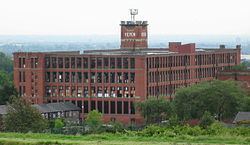Date 1902 Demolished 1960 Engine maker George Saxon & Co Architect Philip Sidney Stott | Built 1905 Opened 1905 Year 1902 | |
 | ||
Engine type vertical cross compound engine Similar Malta Mill - Middleton, Empress Mill - Ince, Regent Mill - Failsworth, Imperial Mill - Blackburn, Century Mill - Farnworth | ||
Heron Mill is a cotton spinning mill in Hollinwood, Oldham, Greater Manchester. It was designed by architect P. S. Stott, and was constructed in 1905 by the Heron Mill Company Ltd next to Durban Mill. It was taken over by the Lancashire Cotton Corporation in the 1930s and passed to Courtaulds in 1964. Production ended in 1960, and it was used by Courtaulds for offices, warehousing and some experimental fabric manufacture.
Contents
- Map of Heron Mill Heron St Oldham OL8 4JS UK
- Location
- History
- Architecture
- Power
- Equipment
- Usage
- Owners
- References
Map of Heron Mill, Heron St, Oldham OL8 4JS, UK
Location
Oldham is a large town in Greater Manchester, England. It lies amongst the Pennines on elevated ground between the rivers Irk and Medlock, 5.3 miles (8.5 km) south-southeast of Rochdale, and 6.9 miles (11.1 km) northeast of the city of Manchester. Oldham is surrounded by several smaller settlements which together form the Metropolitan Borough of Oldham; Chadderton and Hollinwood are such settlements. Chadderton and Hollinwood are served by the Rochdale Canal and the Hollinwood Branch Canal. A rail service was provided by the Oldham Loop Line that was built by the Lancashire and Yorkshire Railway.
History
Oldham rose to prominence during the 19th century as an international centre of textile manufacture. It was a boomtown of the Industrial Revolution, and amongst the first ever industrialised towns, rapidly becoming "one of the most important centres of cotton and textile industries in England", spinning Oldham counts, the coarser counts of cotton. Oldham's soils were unfavorable for crop growing, and so for decades prior to industrialisation the area was used for grazing sheep, which provided the raw material for a local woollen weaving trade. It was not until the last quarter of the 18th century that Oldham changed from being a cottage industry township, producing woollen garments via domestic manual labour, to a sprawling industrial metropolis of textile factories. The first mill, Lees Hall, was built by William Clegg in about 1778. Within a year, 11 other mills had been constructed, but by 1818 there were only 19 of these privately owned mills.
In the second half of the 19th century Oldham became a world centre for spinning cotton yarn. This was due in a large part to the formation of limited liability companies known as Oldham Limiteds. In 1851, over 30% of Oldham's population were employed in the textile sector, compared to 5% across Great Britain. At its zenith it was the most productive cotton spinning mill town in the world. By 1871 Oldham had more spindles than any country in the world except the United States, and in 1909, was spinning more cotton than France and Germany combined. By 1911 there were 16.4 million spindles in Oldham, compared with a total of 58 million in the United Kingdom and 143.5 million in the world; in 1928, with the construction of the UK's largest textile factory Oldham reached its manufacturing zenith. At its peak, there were over 360 mills, operating night and day;
The cotton industry peaked in 1912 when it produced 8 billion yards of cloth. The Great War of 1914–18 halted the supply of raw cotton, and the British government encouraged its colonies to build mills to spin and weave cotton. The war over, Lancashire never regained its markets. The independent mills were struggling. The Bank of England set up the Lancashire Cotton Corporation in 1929 to attempt to rationalise and save the industry. Heron Mill, Hollinwood was one of 104 mills bought by the LCC, and one of the 53 mills that survived through to 1950.
Architecture
The 5-storey mill was built in a group with Durban Mill, and the earlier Brook Mill. It was designed by P.S.Stott. It was extended in 1977. In 1951 it still displayed the decorative features typical of a P. S. Stott mill including the double bands on the mill chimney.
Power
The mill's machines were driven by a 1400 hp vertical cross compound engine, built by George Saxon & Co in 1902. It had a 16 ft flywheel with 32 ropes which operated at 80 rpm. The cylinders 26" HP, 50" LP had a 4 ft stroke. There were Corliss valves on both cylinders. Air pumps were driven from LP crosshead.
Equipment
This was a mule mill with 105,000 spindles in 1915, supplied by Asa Lees.
Usage
It is now used as a warehouse.
